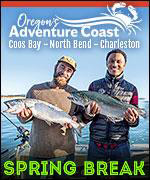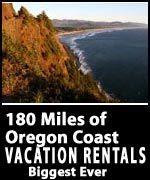Seven Fun and Funky Science Facts of the Oregon Coast
Published 07/17/21 at 5:55 PM PDT
By Andre' GW Hagestedt, editor
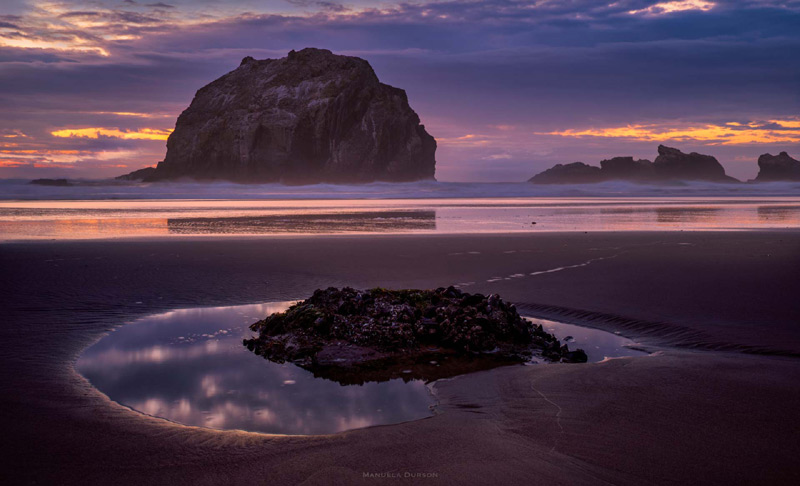
Includes exclusive listings; some specials in winter
In Cannon Beach:
Includes rentals not listed anywhere else
In Manzanita, Wheeler, Rockaway Beach:
Some specials for winter
In Pacific City, Oceanside:
Some specials for winter
In Lincoln City:
Some specials for winter
In Depoe Bay, Gleneden Beach:
Some specials for winter
In Newport:
Look for some specials
In Waldport
Some specials for winter
In Yachats, Florence
Some specials for winter
Southern Oregon Coast Hotels / Lodgings
Reedsport to Brookings, places to stay; winter deals
(Oregon Coast) – What's beneath you and above on these beaches will surprise. From things on the beach that glow, sing, flash, and move in mysterious ways, Oregon's coast has quite a few scientific tricks up its sleeve. Here's a mere seven to ponder. (Above: Face Rock at Bandon, courtesy Manuela Durson Fine Arts )
Southern Oregon Coast a Geologic Jigsaw. There's a vast difference between the south Oregon coast and north coast, and it's right under everyone's feet. Up north, it's much easier to describe a lot of the ancient forces that created those landmarks, but down south it's a massive jigsaw in the geologic sense.
Various parts of the south coast exist on top of different gigantic terranes, basically large, rocky land masses. Stranger still, they were all created somewhere else far away, then slowly moved into place over millions and millions of years. Some of these terranes are as old as 200 million years.
This is true of the north coast as well, but not to the same degree of complexity. Yet on the north coast, most large features like Tillamook Head or the rocks at Depoe Bay can get carbon-dated by geologists and they'll come up with a definite number: about 13 to 17 million years old. But with most of the deeper rocks of the south coast, including those terranes, there's a mish mash of geologic ages in there.
For example, Bandon's Face Rock is a great example: inside it are rocks from many different time periods all smooshed together. See further explanation / origin of Face Rock.
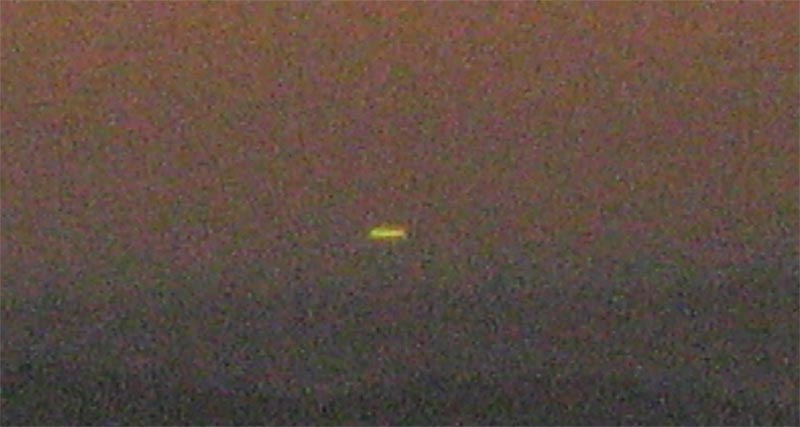
Green Flash at Sunset and Its Cousin, Novaya Zemlya. Sunsets are always a much anticipated moment on the Oregon coast, but some rare ones give an extra show. There is a phenomenon known as the "Green Flash at Sunset," which is a little more apt to happen during summer's lovely weather and fall's "Second Summer" on the coast.
Under the right conditions, you may see a brief green flash directly above the sun, just before the last sliver dips below the horizon. This can only happen on a day of no clouds, and it's the result of a variety of conditions that block out certain color bands for a split second. A little more frequent - but harder to discern - is a slightly longer, green blob that lingers just above the sunset.
Its cousin sometimes creates a green flash. It's called the Novaya Zemlya effect, where you see a two- or three-headed sunset. This is actually a projection of the sun, projected onto different air layers beyond the horizon, requiring a series of unique conditions. According to most documentation, this is a rarity throughout the world, but it seems to happen almost monthly along the Oregon coast. If you see this, look carefully: it may produce a green flash, although usually quite indistinct or fainter than usual. See Strange Weather Cousins on the Oregon Coast: Green Flash and the Novaya Zemlya
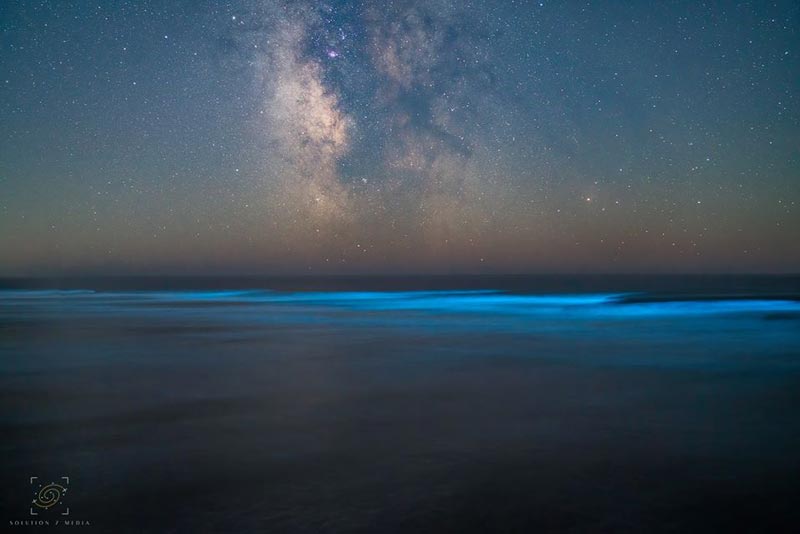
Glowing waves at Fort Stevens, courtesy Solution 7 Media
Sand That Glows – Sand That Sings. Glowing sand happens because of tiny bioluminescent phytoplankton called dinoflagellates. They are like fireflies – but tinier – giving off a faint glow when touched.
Under the right conditions, if you're at the wet sand near the tide line at night, you may see tiny green/blue flashes beneath your feet. Bioluminescent Phytoplankton: What Makes Glowing Sand On Oregon Coast, Washington
The singing sands is much, much rarer and actually happens only at two spots on the coast: in some areas of the National Dunes Recreation Area south of Florence and just south of Cannon Beach.
Sometimes, it sounds like distant voices singing. Others, it's a bit like a violin or an odd, elongated squeaking noise. This, too, only happens under certain conditions, when two different kinds of sands grind together under the right degree of humidity.
It's a tiny bit more frequent in the National Dunes Recreation Area than near Cannon Beach. Even so, park rangers who've worked at the Dunes for 20 years haven't heard it. The sands of Arcadia Beach sometimes make a little squeaking noise when trampled on, which may be where the singing sands legend comes from in that area. But at the dunes it's reportedly more like the standard singing sands anomaly. Oregon Coast's Weird Singing Sands: Cannon Beach, South Coast and Elsewhere | Video
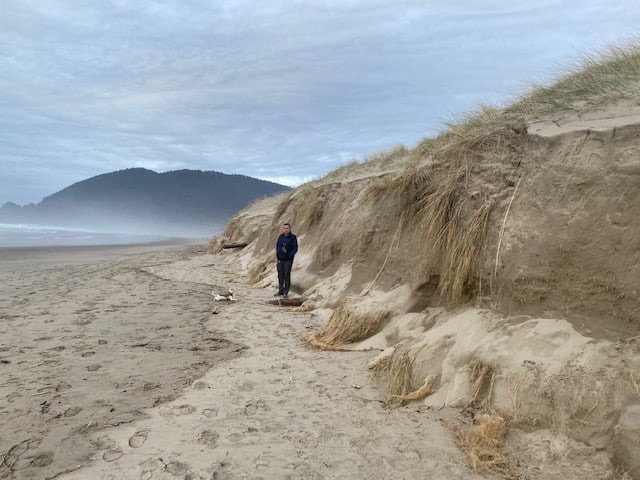
Dunes eaten by winter waves at Manzanita, courtesy Barb Gould
Beaches Change Drastically By Season. There's more to the sands of the coastline than meets the eye.
Your favorite beach can look drastically different in summer compared to winter. Sand levels get scoured out super low in winter, but in summer they can pile tens of feet higher. Both create something wildly different, like access to new places you couldn't get to before, or even odd dangers like massive holes in pools of water you can't see.
Winter brings on crazy amounts of erosion, such as this past year when winter waves ate up beach dunes to alarming degrees. It also reveals ancient bedrock you don't normally see or mysterious ghost forests. See Difference in Sand Levels
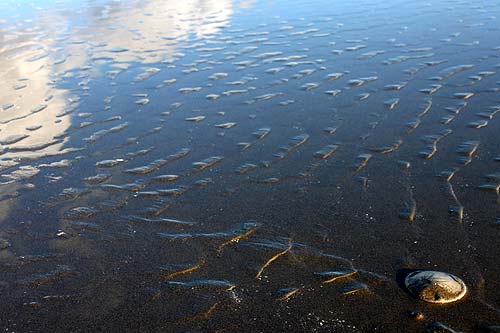
Secrets of Sand Dollars. Finding a whole one on the Oregon coast is quite a treasured moment. But if you find a sand dollar that is still fuzzy, you'll want to leave it alone. It's still alive. Grabbing one and putting it in your car will yield an unpleasant surprise. It will stink to high heaven shortly.
Stick to the clay-like, grayish ones you find. Luckily, coming across a still-alive sand dollar is fairly rare. See more about Oregon coast sand dollars.
Oregon Coast Hotels for this - South Coast Hotels - Where to eat - Maps - Virtual Tours
Cannon Beach Lodging
Nehalem Bay Lodgings
Manzanita Hotels, Lodging
Three Capes Lodging
Pacific City Hotels, Lodging
Lincoln City Lodging
Depoe Bay Lodging
Newport Lodging
Waldport Lodging
Yachats Lodging
Oregon Coast Vacation Rentals
Oregon Coast Lodging Specials
More About Oregon Coast hotels, lodging.....
More About Oregon Coast Restaurants, Dining.....
LATEST Related Oregon Coast Articles
Travel Advice: Traffic Cams for I-5, I-205, I-405, Hwy 217, I-84, OR 26
Low Tide Oceanside Events Take You Deeper Into N. Oregon Coast Tidepools
June 13, 26, 27, and 28, these uncover the wonders at the water's edge. Oceanside events, Pacific City events, Tillamook events, Netarts
Military Truck Tours Back at Fort Stevens, Go Back in Time on N. Oregon Coast
Hop aboard a five-ton military truck and rove around the grounds. History. Astoria events, Warrenton
Newport Astrophotography Events Bring the Universe to Central Oregon Coast
July 25 at Frank Wade Park, August 16 at Newport Rec Center, Aug. 23 - 24 road trip. Nwport events
Lincoln City Summer Kite Fest Returns, with Nod to Oregon Coast's Famed Pixie...
June 21 - 22 at the D River State Recreation Site. Lincoln City events
Rare Lunar Event Tonight Won't Happen Again for Almost 20 Years: Oregon, Wash...
Moon at lowest on the horizon it's been in 20 years; plus 'full moon effect'. Sciences, astronomy
Bandon's Circles in the Sand Returns to S. Oregon Coast, Full Summer and Shut...
Into mid-August with parking shuttles a great assist. South coast events, Bandon events
Summer's Surprise Rate Drops in July On Oregon Coast Include Lincoln City Bea...
20 percent some vacation rentals in the heat of July's highest rates. Lincoln City lodging specials, Lincoln City hotel reviews
Back to Oregon Coast
Contact Advertise on BeachConnection.net
All Content, unless otherwise attributed, copyright BeachConnection.net Unauthorized use or publication is not permitted














